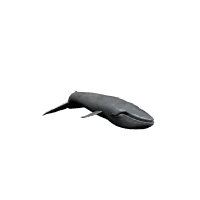  |
  |


Whale watching is the biggest show on earth. With the ocean as their stage, the spellbinding and entertaining whales put on daily star performances for the whale watch cruises visiting their feeding grounds. In this article you'll discover how to get the most out of your trip.
Picture this... a warm summer afternoon on a boat in a gentle rolling ocean. A cooling breeze softly massages your face where you sit, and you begin to close your eyes and drift away... the sound of the boat's engine begins to fade and finally stops. The boat, like you, is drifting over the waves and following the breeze. It's very peaceful and calm and after a stressful week at work you finally feel in harmony with the world.
Then something explodes... out of the water... and only a few feet from your nose! A 30-ton humpback... the length of a large house... it breaches... and in another second is gone. And you're left in disbelief and wonder. And it's just the start of your whale watching!
While whales are scattered throughout the world there's only a handful of accessible locations to view them in their natural environment. The coastal waters of New England and the west coast of North America are prime locations for whale watching. Hawaii and South Africa are also superb locations to spot whales, as are the ocean waters around New Zealand. So if a vacation or trip takes you to any of these areas make sure you book a cruise and take in the biggest show on earth.
Here's five things to remember to ensure you have an enjoyable whale watch.
PLAN YOUR WHALE WATCHING TRIP
It may seem obvious but book in advance for your trip to avoid long lines or even disappointment. Usually at least one week before the trip is recommended. Whale watching cruises can last anywhere from 3 hours to 41/2 hours, and the length depends on how long it takes to find the whales. If you're easily bored staring at the open ocean then take along a novel or your iPod, or something to entertain young children if they're part of your group. While most boats are equipped with a place to buy food and drink they don't usually mind you taking your own pack lunch or snacks to keep the costs down.
WHAT TO LOOK FOR IN A WHALE WATCH CRUISE
I've two criteria when I choose a whale watch cruise company. How long have they been in business and does it have whale experts on staff? You can usually uncover this information by checking out their web site or calling them.
Most whale watch boats use sophisticated sonar and communications equipment to find the whales, but as I'm not an expert in equipment I look to see if a company has a history of organizing whale watch trips. Good experience is usually a sign they're doing something right and a safe bet. I also like to see at least one scientist or naturalist on the crew narrating the tour, as having a knowledgeable authority provides a better understanding of what you're seeing.
CHECK FOR A WHALE SIGHTING GUARANTEE
It happens occasionally you don't get to see a whale. These mammals are unpredictable, and while the captain will make every effort to uncover their location, some days they're nowhere to be found. So make sure you book on a cruise that offers a guarantee sighting or you get to cruise again for free. Offering a guarantee is another good sign of a confident and experienced whale watch company.
WHALE WATCHING IS DONE ON THE OPEN OCEAN.
Experienced whale watch cruise companies do not go out in rough seas, but the whale feeding grounds are normally miles from land in the open ocean. Even at the height of summer the open sea can still be choppy, and so if you suffer with motion sickness then take something about an hour before you board the cruise.
QUICK CHECK OF WHALE WATCHING EQUIPMENT.
Recommended things to bring on your whale watch are a camera and plenty of film or memory cards. Take or borrow a pair of binoculars, as whales many times surface yards from the boat, and having binoculars will provide close up views other passengers just won't get.
As for clothing, wear sneakers or something rubber-soled for good traction on a wet and slippery deck. And take sunscreen, sunglasses, and if it's got a tie strap - a hat. Because of the breeze on open water take a sweatshirt just in case of temperature drop, especially for a late afternoon trip. The boats will go out in the rain, so if you've got a poncho pack it as well. I put most of my whale watch necessities in a small fanny pack.
Whales are mesmerizing mammals that've traveled thousands of miles to feed in their playground coastal waters. They don't stay for long so go ahead and book your whale watch adventure and prepare for the biggest show on earth.

| © RIYAN Productions |